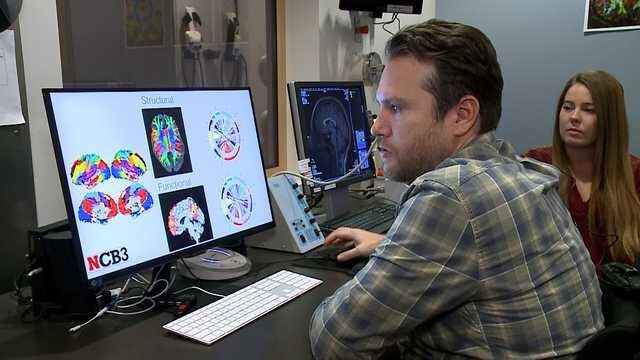NU lab hopes ground-breaking concussion research will help athletes

"That is a very scary thing to watch
By Andrew Ozaki
Click here for updates on this story
NEBRASKA (KETV) — It was an image that players, coaches and fans don’t want to see — Miami Dolphins quarterback Tua Tagovailoa knocked unconscious, his fingers contorted as he laid motion-less on the field.
Tagovailoa suffered a reported back injury during another game just five days earlier but was cleared to play.
It sparked a renewed debate of the NFL’s concussion protocol.
“That is a very scary thing to watch, somebody’s brain reacts so strongly that they fence or posture, you know, their muscles contract,” said Dr. Kate Higgins, University of Nebraska Medical Center neuropsychologist.
She is part of the team that tries to keep University of Nebraska athletes safe.
“We have a true sort of interdisciplinary team that surrounds our athletes that get concussed,” Higgins said.
Since 2019, Higgins has also worked for the University of Nebraska Athletics Dept.
She has overseen baseline testing, evaluations and management of concussions for athletes.
She her evaluations are not influenced by coaches, trainers and players.
“We managed concussions, we try and do it much more objectively than it was done before we had all these tools in place,” Higgins said.
Right now, it’s done on a clinical basis, looking at cognitive function by answering questions, testing balance and eye movements. But the university is working to add more tools through research at its Center for Brain Biology and Behavior Lab located in the southeast corner of Memorial Stadium.
“What we’re doing is is unique in the country and probably in the world,” CB3 Lab Director Cary Savage said.
The lab is a collaboration with the NU Athletic Department. Since 2018 the Huskers have captured baseline Magnetic resonance imaging (MRI) scans of almost every football player.
Women’s soccer was added in 2019.
Athletes are also scanned if they get a head injury and then after recovery.
“What we hope is that we will have bio markers of concussion and ‘likely good recovery’ ‘likely poor recovery’ that the team doctors can use to help make decisions, Savage said. “I would like to give the physicians the best data they can get.”
They’ve tested more than 400 athletes and studied 45 concussions for men and five for women. Researchers have found trauma to certain areas of the brain, called hubs, can cause more disruptions.
“Think of them as airport terminals,” UNL Research Assistant Professor of Psychology Doug Schultz said.
“If a winter storm knocks out O’Hare, it’s chaos,” Schultz said.
Schultz said the degree of disruption seems to be related to how many symptoms the athlete shows following concussion. They also found indications of recovery.
“What we’ve seen is that the vast majority of things that may have been different following concussion are back to sort of baseline levels,” Schultz said.
But it’s still not clear how to determine degrees of recovery and predict how fast it will occur. The other question is why some athletes with repeated concussions develop Chronic traumatic encephalopathy (CTE), a crippling neurodegenerative condition, and others do not.
“There’s still a lot of things we don’t know,” Dr. Higgins said. “I’m guessing it’s probably not as simple as you get head injuries, you end up with CTE there are probably a myriad of things on the like front end and the back end of those injuries.”
Still, Higgins said she’s had to have a few tough conversations with athletes who get concussed more often and with less force who are taking longer to recover.
“They don’t make it to this level unless they are committed to their sport, which makes them super driven and super competitive. So, having to have the conversation of ‘you’re not recovered enough for you to be able to go back into play’ is a terrible conversation to have. But you do it because long term that is the best thing for the athlete. That is the safest thing for the athlete,” Higgins said.
The CB3 Lab is finishing up a collaboration with the Big Ten and Ivy League conferences to study concussions. Savage hopes the study will continue with more conferences.
Researchers would like a standardization of concussion care through out sports.
“We can bury our head in the sand and pretend there’s not a problem. But I think if we want to make sure that football continues as the type of sport it is, a gladiator sport, we need to understand concussion and understand the long term implications,” Savage said.
Please note: This content carries a strict local market embargo. If you share the same market as the contributor of this article, you may not use it on any platform.